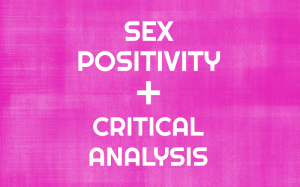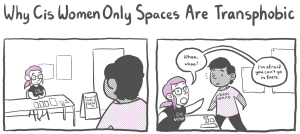
A young person doing the Cobra pose on a yoga mat outdoors.
Yoga is not feminist.
Or that’s what you might think if you only know yoga through the lens of our capitalist, body-shaming, fitness-obsessed American culture.
Seeing magazine covers of thin, wealthy, White, cis women talking about “how to get yoga abs” certainly isn’t appealing for those of us working to eradicate inequality and oppression – nor does it make us want to give the practice a try.
Cultural appropriation is another serious problem in American yoga today.
The historical and contemporary colonization process of Western yoga serves to whitewash and erase yoga’s South Asian roots, while privileging the voices and bodies of White (heterosexual, cisgender, and wealthy) Americans as the owners, purveyors, and consumers of yoga.
This is certainly not feminist. Heterosexism, cultural appropriation, racism, inaccessibility, profit-driving, gender policing, and body shaming are not feminist values; in fact, recognizing and fighting against them are a necessary part of an intersectional feminist movement. And yet, these are all very present elements of yoga in America today.
They’re also completely counter to the values of the practice.
Feminism and yoga are in no way contradictory. In fact, despite all of this, I would argue that yoga and feminism are authentically bound. Despite the destruction that Western patriarchal capitalism has had on yoga practice and culture, yoga holds subversive, feminist elements that can strengthen our movement.
So what role can yoga play in the feminist movement? How does yoga challenge capitalism and systemic oppression, or strengthen our ability to be agents of social change?
What is so feminist about yoga?
Here are four things to consider.
1. Yoga Changes Our Relationships to Our Bodies
“By being physical without a focus on weight-loss or competition, yoga can help you become a witness to negative self-talk that comes from years of misguided influence of the media and other cultural forces. Despite what Instagram might look like, yoga can help you reject attachment to cultural beauty standards so that you can feel comfortable in your own skin.” —Veronica Rottman, feminist yoga instructor and doula
Although yoga has only in the last several decades begun to occupy a visible place in the American mainstream, yoga has been practiced globally for over 5,000 years. The word yoga comes from the Sanskrit root “yuj” meaning “to yoke,” or “to come together,” “to unite.”
The union of the mind and body is at the core of yoga and is certainly no small goal. We tend to view the mind and body as separate things in our culture, and we promote division by prioritizing one over the other.
Certainly, living under an endless amount of body-shaming, victim-blaming, and social pressures around sex and body image creates a context for toxic relationships with our bodies.
Feminism takes up this cause by examining, deconstructing, and challenging these norms. Yoga takes up the cause through the practice of embodiment. This process means connecting and reconnecting and coming into our bodies just by noticing what we’re feeling without judgment or any attempt to control or change those physical and emotional experiences.
Our bodies hold our life stories. They hold our grief and trauma, our anxiety, our sadness, our joy, our histories. And while we live in an incredibly cognitive world, we can’t always verbally explain what’s happened and is happening in our bodies. In fact, most of the time, we don’t even notice or care. The division of our “self” from our bodies allows the space for constant negative self-talk, criticism, and punishment of our bodies for just being what they are.
In a world that teaches us to constantly try to “take control” over ourselves – our bodies, our weight, our health, our emotions – it can be a radically feminist experience to learn to simply hold the space for our bodies to feel whatever sensations arise, to allow ourselves to carry what our bodies want to hold onto, to let go of what they no longer need, to breathe in their history and each passing moment.
This is what yoga teaches – to be in our bodies, fully, and to love the movement and sensations and emotions, with all their complexity.
2. Yoga Can Help Us Heal From Trauma
“Feminism offered the ideological tools to examine my tortured relationship with my body systematically and deconstruct mediated images. Yoga provided the practice that rooted the things feminism had taught me. It is one thing to intellectualize self-love and acceptance, it’s another to embody it.” —Melanie Klein, academic, feminist, yoga instructor
To live in this world as a person of marginalized identities is to experience trauma.
As I’ve discussed in past posts, oppression is immensely bad for your mental health. Healing from the systemic and interpersonal violence that one endures in this world, then, must hold a central role in our movement.
We cannot build a movement of strength without acknowledging the daily trauma (big T and little t) that has been carried out in the name of white supremacy, patriarchy, capitalism, and other systems of oppression.
When it comes to healing from trauma, both yoga and feminism play important and overlapping roles. While feminism gives us the framework for letting go of internalized shame, yoga grounds that healing in our bodies.
Increasing research shows that because we hold trauma in our bodies, yoga often gives us the tools we need to release it, to let go of the weight and conditioning and to find a new strength for moving through the world.
This process of healing and building strength and power is such a central part of our work. To be a part of this movement is to acknowledge the trauma inherent in living under and alongside rape culture, police violence in Black communities, violence against abortion providers, the prison industrial complex, gender and sexuality-based hate crimes, and the list goes on and on.
We are witnesses to this trauma, and we are survivors of it. The practice of being present to it, to being awake, and to healing are central to yoga, and central to our social justice work.
The practice of yoga is not only healing – its philosophy also speaks to our social justice goals: The ultimate goal of yoga is liberation.
Yogic philosophy also holds values such as ahimsa, or nonviolence, and kharma, or selfless action, at its core. Yoga, like feminism, seeks to dismantle and deconstruct cultural notions and belief systems through critical thinking, or kind questioning.
It values non-duality and fluidity of the self and in our expression of gender. The idea of “wiping the fog from the mirror” is a common one in yoga – that we can wipe away that which clouds our clarity, that we can be increasingly conscious and awake to what is happening around us.
Yoga, then, can teach us not only to let go of harmful and rigid constructions of self as we heal from trauma, but fills that space with a framework grounded in liberation and taking action.
3. Yoga Helps Us Cultivate Being Here Now
“The practice of yoga only requires us to act and to be attentive to our actions.” —T.K.V Desikachar
Yoga isn’t just about moving your body. Sure, we make cool shapes in a yoga class, but the practice is about so much more than that. In fact, yoga has eight limbs, only one of which includes the physical poses (asana). Other limbs focus on ethical standards, self-discipline, the steps of meditation, as well as connecting to our breath and to the present moment.
Yoga teaches us to sit in the present moment, to notice every sound, sensation, action – and to notice these things without judgment. This is also called mindfulness, and it is an incredibly challenging thing to practice.
It means being here now, in this moment, and facing whatever we may be trying to avoid by distracting ourselves with work, substances, or television. It also means truly seeing the people and other living beings around us. Seeing them not as separate from us, but as deeply connected.
While capitalism and oppression teach us to strive to “get ahead,” to compete and compare and criticize ourselves and others, yoga teaches us to accept ourselves and those around us. While capitalism values productivity and efficiency, yoga values slowing down and inaction. While capitalism teaches us we don’t own our own bodies or our labor or our time, to always be thinking of the future as a way to get through the long days of work, yoga teaches us that no one can “own” our time or bodies, and that the only way to truly live is to be fully awake to each and every moment.
While capitalism and systemic oppression serve to isolate us from one other and to separate us from our time, our labor, ourselves, and everything around us, yoga teaches us to connect with the present moment, and to the beings around us.
When we take action as a collective, as beings who are deeply connected to one another, we are better able to position the values of empowerment, equality, and empathy at the center of our work – and become a stronger feminist movement because of it.
4. Yoga Teaches Both Acceptance and Change
“Yoga teaches us to cure what need not be endured and endure what cannot be cured.” —B.K.S. Iyengar
When I first started studying yoga, I remember having a really hard time with that word – acceptance. Why would I work toward a place of acceptance when there is so much in this world that needs changing? Isn’t acceptance of each moment counter-revolutionary?
While it can be difficult to hold both ideas at once, it’s possible (and even radical!) both to accept each moment as it is, while rejecting the oppressive violence around us and taking action to enact change.
We can hold that each moment is true and real and authentic while wanting events of those moments to be different. We can hold that we are who we are and where we are, while wanting both of those things to be better.
But we have to start where we are.
I think one of the hardest parts of being an activist is that change is so. frustratingly. slow.
And in a world where waking up to the truth of the terror happening around you can easily set you up for a lifetime of endless anger and frustration, it’s absolutely necessary that we make space for connection and joy.
It’s a long road to change, and burn-out is all too common in our movement. Yoga teaches us how to do just that – to be both patient and demanding for the necessary revolution; to accept and be grateful for each small change as we remain rooted in our larger vision and thirst for deeper shifts; to be awake to the beauty and power offered in each breath and moment, while challenging the emptiness, alienation, self-blame, and disconnection upon which oppression and marginalization thrives.
We need and deserve to see the beauty around us amidst the violence. By doing this, we remind ourselves what kind of world we’re fighting for, and keep that fire for justice burning.
Yoga also teaches us how to hold humility and an openness to learning, especially when it comes to learning from the wisdom of both yoga and feminism’s long history.
In our work, it’s essential to be open to learning from our history – from both the narrow, destructive past of White feminism’s exclusionary vision to the infinite wisdom of radical, intersectional feminists.
While Western yoga culture may position itself as ahistorical, taking credit for its own profit-driven existence, a feminist yoga practice teaches us that we are intimately connected to its long, vibrant history, as well as to its destructive colonization and appropriation from its spiritual roots and culture.
This awareness, gratitude, and openness grounds us in the wisdom of the past while teaching us to create an intention for the present and future.
***
While I firmly believe that yoga can hold a major role in our movement, this is by no means a call to embrace yoga culture as it exists in America.
There are real problems with the way yoga in this country is practiced and with whom it excludes. But I don’t think this means rejecting yoga completely. Instead, I would argue that the qualities of yoga that reaffirm marginalization and exclusion are definitively un-yoga. They’re counter to yogic philosophy.
There’s a difference between yoga culture and yoga practice – the larger yoga culture in America may be way too body-shaming and appropriative, but your practice doesn’t need to be. Take it from Sparkle Thornton and Dianne Bondy and Nick Krieger and Jessamyn Stanley. Take it from BlackWomenYoga and Queer and Trans Yoga and the Prison Yoga Project.
As we work to make our studios and practices more accessible, inclusive, and critical of the racist, heterosexist, cissexist, and cultural appropriative elements of yoga, we can also work to integrate the elements of yoga we find most beneficial into our movement.
I believe that yoga can only make us stronger activists – radicals with more energy, gratitude, presence, and deeper connections to one another and our planet.
While feminism continues to be our ideological framework for understanding and critiquing oppression, yoga can be the tool to ground us in that framework, to practice the awareness, compassion, and self-love that will create the space for us to be agents of change.
Just start where you are.
[do_widget id=’text-101′]
Laura Kacere is a Contributing Writer for Everyday Feminism and is a therapist, yoga teacher, and pit bull mama living in Chicago. Laura moved to Chicago to study mental health after years of reproductive rights activism in Washington, D.C. She is passionate about about working at the intersection of feminism, mental health, and the body. When she isn’t working or on her mat, she’s usually watching Buffy, eating deep dish pizza, and wishing she had more string instruments. Follow her on Twitter @Feminist_Oryx. Read her articles here.
Search our 3000+ articles!
Read our articles about:
Our online racial justice training
Used by hundreds of universities, non-profits, and businesses.
Click to learn more




















